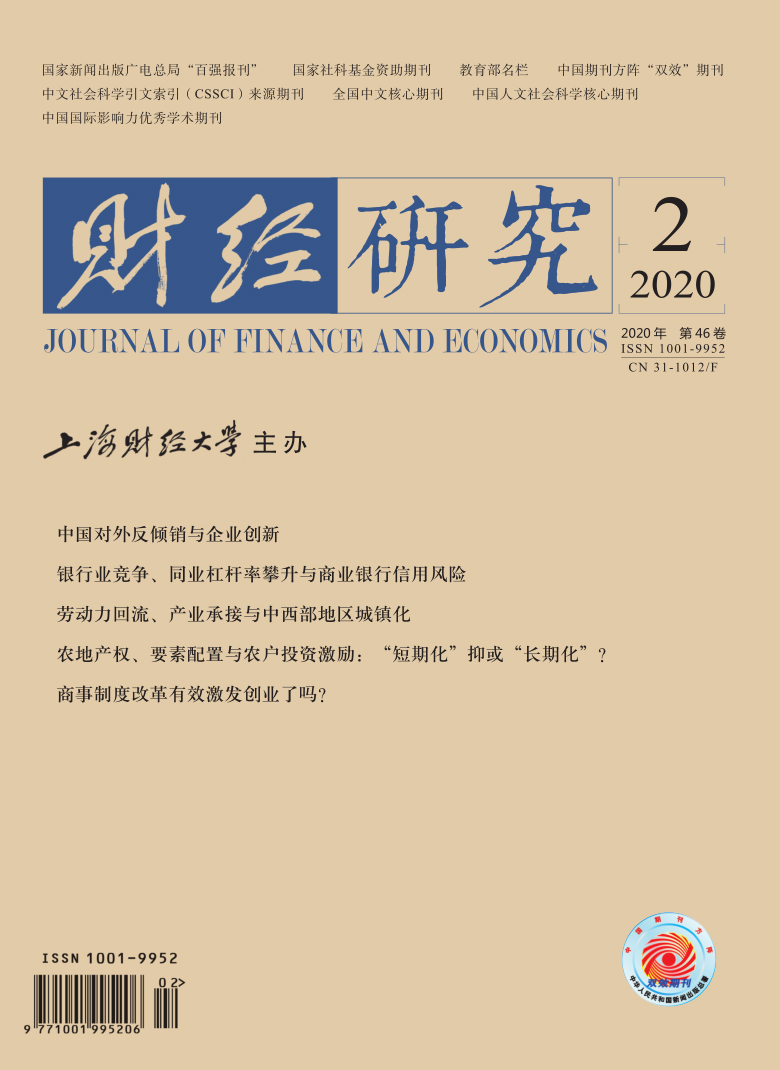自1995年以来,中国遭受反倾销的诉讼数量都居于全球首位,这意味着中国企业面临着严峻的反倾销形势。然而,现有文献大多关注反倾销对中国出口贸易的不利影响,没有注意到这一严峻形势可能产生的“倒逼效应”。基于此,文章测算了2000−2013年中国企业的出口产品质量水平,并利用世界银行全球反倾销数据库,采用双重差分法分析了国外对华反倾销对中国企业出口产品质量的影响,试图从出口产品质量的视角揭示遭遇反倾销可能带来的“意外之喜”。研究表明:(1)中国企业在遭受反倾销后,确实会对其出口行为进行调整,从而推动出口产品质量的上升。(2)遭受反倾销对出口国产品质量的提升作用会受到企业特征和产品特征的影响,即反倾销前企业出口产品质量越低、企业生产率水平越低、产品替代弹性越大,则反倾销对企业出口产品质量的提升作用越大。(3)异质性分析表明,遭受反倾销后,中西部地区企业、单一产品或单一出口目的国企业、国内企业的产品质量提升较大。文章对于中国企业如何正视反倾销的影响,调整贸易策略,提高出口产品质量来趋利避害具有重要的启示。
反倾销如何影响出口产品质量?
摘要
参考文献
3 樊海潮,郭光远. 出口价格、出口质量与生产率间的关系:中国的证据[J]. 世界经济,2015,(2):58−85. DOI:10.3969/j.issn.1007-1369.2015.02.005
10 苏振东,邵莹. 对外反倾销措施能否改善中国企业绩效?−以化工产品“双酚A”案件为例[J]. 经济评论,2013,(4):81−87.
11 苏振东,邵莹. 对外反倾销能否提升中国企业生存率−以化工产品“双酚A”案件为例[J]. 财贸经济,2014,(9):82−93. DOI:10.3969/j.issn.1005-913X.2014.09.049
13 王孝松,施炳展,谢申祥,等. 贸易壁垒如何影响了中国的出口边际?−以反倾销为例的经验研究[J]. 经济研究,2014,(11):58−71.
17 Amiti M,Khandelwal A K. Import competition and quality upgrading[J]. Review of Economics and Statistics,2013,95(2): 476−490. DOI:10.1162/REST_a_00271
18 Amiti M,Konings J. Trade liberalization,intermediate inputs,and productivity:Evidence from Indonesia[J]. American Economic Review,2007,97(5): 1611−1638. DOI:10.1257/aer.97.5.1611
19 Aw B Y,Roberts M J. Measuring quality change in quota-constrained import markets:The case of U.S. footwear[J]. Journal of International Economics,1986,21(1-2): 45−60. DOI:10.1016/0022-1996(86)90004-8
20 Baldwin R,Harrigan J. Zeros,quality,and space:Trade theory and trade evidence[J]. American Economic Journal:Microeconomics,2011,3(2): 60−88. DOI:10.1257/mic.3.2.60
21 Bas M,Strauss-Kahn V. Input-trade liberalization,export prices and quality upgrading[J]. Journal of International Economics,2015,95(2): 250−262. DOI:10.1016/j.jinteco.2014.12.005
22 Boorstein R, Feenstra R C. Quality upgrading and its welfare cost in U.S. steel imports, 1969-74[A]. Helpman E, Razin A. International trade and trade policy[M]. Cambridge, MA: MIT Press, 1991.
23 Bown C P,Crowley M A. Trade deflection and trade depression[J]. Journal of International Economics,2007,72(1): 176−201. DOI:10.1016/j.jinteco.2006.09.005
24 Broda C,Weinstein D E. Globalization and the gains from variety[J]. Quarterly Journal of Economics,2006,121(2): 541−585. DOI:10.1162/qjec.2006.121.2.541
25 Correia S. REGHDFE: Stata module to perform linear or instrumental-variable regression absorbing any number of high-dimensional fixed effects[EB/OL]. https://econpapers.repec.org/software/bocbocode/S457874.htm, 2018.
26 De Loecker J,Goldberg P K,Khandelwal A K,et al. Prices,markups,and trade reform[J]. Econometrica,2016,84(2): 445−510. DOI:10.3982/ECTA11042
27 Falvey R E. The composition of trade within import-restricted product categories[J]. Journal of Political Economy,1979,87(5): 1105−1114. DOI:10.1086/260814
28 Fan H C,Li Y A,Yeaple S R. Trade liberalization,quality,and export prices[J]. Review of Economics and Statistics,2015,97(5): 1033−1051. DOI:10.1162/REST_a_00524
29 Fan H C,Li Y A,Yeaple S R. On the relationship between quality and productivity:Evidence from China’s accession to the WTO[J]. Journal of International Economics,2018,110: 28−49. DOI:10.1016/j.jinteco.2017.10.001
30 Feenstra R C. Voluntary export restraint in U.S. autos, 1980-81: Quality, employment, and welfare effects[A]. Baldwin R E, Krueger A O. The structure and evolution of recent U.S. trade policy[C]. Chicago: University of Chicago Press, 1984.
31 Feenstra R C. Quality change under trade restraints in Japanese autos[J]. The Quarterly Journal of Economics,1988,103(1): 131−146. DOI:10.2307/1882645
32 Feng L,Li Z Y,Swenson D L. The connection between imported intermediate inputs and exports:Evidence from Chinese firms[J]. Journal of International Economics,2016,101: 86−101. DOI:10.1016/j.jinteco.2016.03.004
33 Goldberg P K. Trade policies in the U.S. automobile industry[J]. Japan and the World Economy,1994,6(2): 175−208. DOI:10.1016/0922-1425(94)00013-1
34 Goldberg P K. Product differentiation and oligopoly in international markets:The case of the U.S. automobile industry[J]. Econometrica,1995,63(4): 891−951. DOI:10.2307/2171803
35 Hallak J C. Product quality and the direction of trade[J]. Journal of International Economics,2006,68(1): 238−265. DOI:10.1016/j.jinteco.2005.04.001
36 Hummels D,Klenow P J. The variety and quality of a nation’s exports[J]. American Economic Review,2005,95(3): 704−723. DOI:10.1257/0002828054201396
37 Johnson R C. Trade and prices with heterogeneous firms[J]. Journal of International Economics,2012,86(1): 43−56. DOI:10.1016/j.jinteco.2011.09.004
38 Khandelwal A K,Schott P K,Wei S J. Trade liberalization and embedded institutional reform:Evidence from Chinese exporters[J]. American Economic Review,2013,103(6): 2169−2195. DOI:10.1257/aer.103.6.2169
39 Konings J,Vandenbussche H. Heterogeneous responses of firms to trade protection[J]. Journal of International Economics,2008,76(2): 371−383. DOI:10.1016/j.jinteco.2008.08.002
40 Konings J,Vandenbussche H,Springael L. Import diversion under European antidumping policy[J]. Journal of Industry,Competition and Trade,2001,1(3): 283−299. DOI:10.1023/A:1015269804381
41 Krishna K. Tariffs versus quotas with endogenous quality[J]. Journal of International Economics,1987,23(1−2): 97−122. DOI:10.1016/S0022-1996(87)80007-7
42 Krishna K. Protection and the product line:Monopoly and product quality[J]. International Economic Review,1990,31(1): 87−102. DOI:10.2307/2526630
43 Kugler M,Verhoogen E. Prices,plant size,and product quality[J]. The Review of Economic Studies,2012,79(1): 307−339. DOI:10.1093/restud/rdr021
44 Lu Y,Tao Z G,Zhang Y. How do exporters respond to antidumping investigations?[J]. Journal of International Economics,2013,91(2): 290−300. DOI:10.1016/j.jinteco.2013.08.005
45 Pavcnik N. Trade liberalization,exit,and productivity improvements:Evidence from Chilean plants[J]. The Review of Economic Studies,2002,69(1): 245−276. DOI:10.1111/1467-937X.00205
46 Ries J C. Voluntary export restraints,profits,and quality adjustment[J]. Canadian Journal of Economics,1993,26(3): 688−706. DOI:10.2307/135895
47 Rodriguez C A. The quality of imports and the differential welfare effects of tariffs,quotas,and quality controls as protective devices[J]. Canadian Journal of Economics,1979,12(3): 439−449. DOI:10.2307/134732
48 Romalis J. Market access, openness and growth[R]. NBER Working Paper No. w13048, 2007.
49 Russo J E. The human cost:A comment on dardis[J]. Journal of Consumer Policy,1987,10(1): 89−92. DOI:10.1007/BF00411947
50 Schott P K. Across-product versus within-product specialization in international trade[J]. The Quarterly Journal of Economics,2004,119(2): 647−678. DOI:10.1162/0033553041382201
51 Topalova P,Khandelwal A. Trade liberalization and firm productivity:The case of India[J]. Review of Economics and Statistics,2011,93(3): 995−1009. DOI:10.1162/REST_a_00095
52 Vandenbussche H,Wauthy X. Inflicting injury through product quality:How European antidumping policy disadvan- tages European producers[J]. European Journal of Political Economy,2001,17(1): 101−116. DOI:10.1016/S0176-2680(00)00030-6
53 Verhoogen E A. Trade,quality upgrading,and wage inequality in the Mexican manufacturing sector[J]. The Quarterly Journal of Economics,2008,123(2): 489−530. DOI:10.1162/qjec.2008.123.2.489
引用本文
高新月, 鲍晓华. 反倾销如何影响出口产品质量?*[J]. 财经研究, 2020, 46(2): 21-35.
导出参考文献,格式为:
下一篇:政府补贴对企业就业波动的影响研究






 5078
5078  6063
6063

